Search the Site
Popular pages.
- Historic Places of Los Angeles
- Important Issues
- Events Calendar

Case Study House #28
The last single-family house built under the Case Study House program is also among the largest.
Place Details
- Conrad Buff,
- Don Hensman
Designation
- Private Residence - Do Not Disturb
Property Type
- Single-Family Residential
Case Study House #28 was the last single-family house built under the auspices of Arts & Architecture magazine’s Case Study House program. At 5,000 square feet, it is also among the largest. Construction began in 1965 and the residence was completed in 1966. It was built on a knoll overlooking the Janss Development Corporation’s Conejo Development in Thousand Oaks.
Designed by Conrad Buff and Donald Hensman, the house features steel frame construction but is sheathed in face brick, owing to the building’s sponsorship by the Pacific Clay Products Company.
The architects were asked by Janss and Pacific Clay Products to design a house that used face brick, a unifying material throughout the development, as a structural material to demonstrate its advantages. However, a steel frame was incorporated in the design to supplement the brick.
The design of Case Study House #28 is an alternative to previous houses in the program that consisted primarily of glass and exposed steel. Here, the exposed brick resulted in a finish requiring little to no maintenance. The steel framed brick walls allowed the architects large expanses of glass, including clerestories. The footprint of the house includes two parallel symmetrical wings, 95-feet by 19-feet each, connected by two parallel glazed corridors. One wing is devoted to private family spaces and incorporates five bedrooms and three baths, while the other wing includes living, dining, kitchen, family, and powder rooms.
The wings of the house and glazed corridors form an outdoor central courtyard, paved in brick, with a swimming pool and planting areas that provide the classic indoor-outdoor visual connection afforded by the predominant use of floor-to-ceiling perimeter glass. This design exemplified the classic concept in modern architecture of merging interior and exterior spaces through glass expanses and seamless materials.
View the National Register of Historic Places Nomination
Issues including Case Study House #28
Case study houses, related content, bailey house (case study house #21), columbia savings (demolished), driftwood drive-thru dairy pole sign.
Case Study House 28. Conrad Buff and Donald Hensman
The only house of its kind to be built in Ventura County, California, Case Study House #28 was the last single-family home designed and constructed by renowned architects Conrad Buff and Donald Hensman of the firm Buff, Hensman and Associates (now Buff, Smith and Hensman).
Covering almost 5,000 square feet, #28 is one of the largest projects in the Case Study House program and is now, alongside many other of these fascinating constructions, protected by the National Park Service.
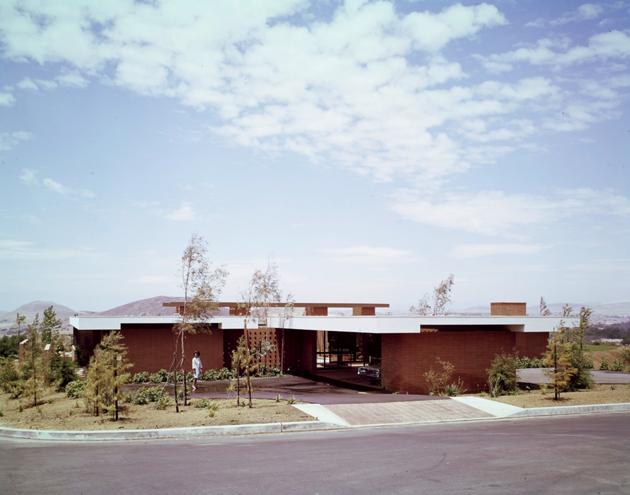
Consisting of just one expansive floor, the house itself is designed as a hybrid in which the steel frame structure, left exposed in many of Buff and Hensman’s previous domestic designs, is concealed by clay bricks.
This change in the design process allowed the Janss Development Corporation and Pacific Clay Products to demonstrate the advantages of using brick in modern architectural design .
The use of heavy steel and brick is alleviated by over 4,000 square feet of clerestory glass windows that work to seamlessly integrate the interior areas of the house with its multiple courtyards and impart on Case Study House #28 the notions of classic mid-century modern architecture.
The overall periphery of the house approximates a square composed of two rectangles which are separated by a garden court and linked by two glass-enclosed galleries.
By creating two separate wings and placing them physically apart from one another, the architects were able to divide the areas of the house used for everyday family activities from those used for rest and relaxation . This split design permits the family privacy and flexibility in their everyday lives whilst enabling a togetherness and intimacy that results from spreading the house over a single floor.
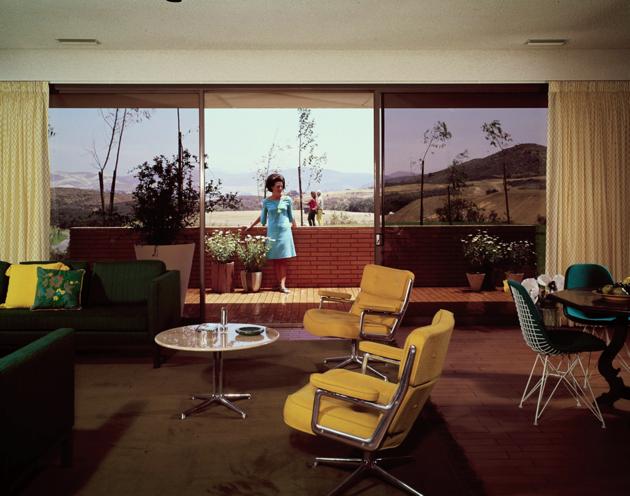
The area inside the square, occupying the space between the two parallel wings of the house and their perpendicular glass corridors, consists of an expansive courtyard which houses a swimming pool and garden area .
The placement and design of Case Study House #28’s courtyard, an area enclosed by the structure of the house but permeated by shaded glass windows and transparent walkways, works to define the area as the physical and visual focal point of the house while simultaneously communicating a feeling of security and privacy that only comes with structurally enclosed gardens.
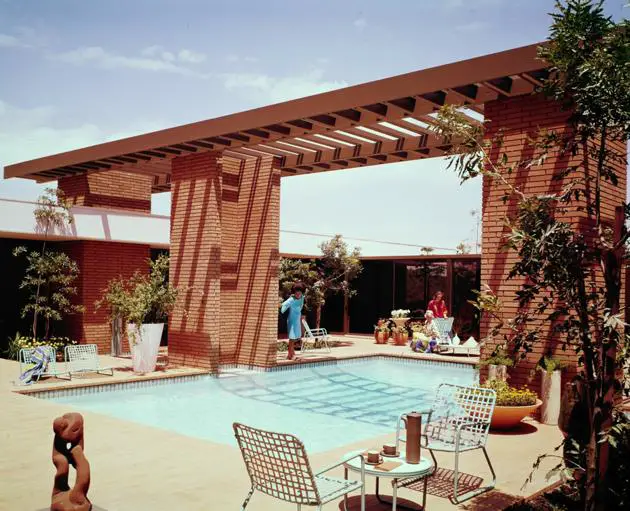
Throughout the courtyard the architects included areas of shaded brick patio that offered relief from the direct rays of sunshine that affect the more central areas of the garden area. These sections of slightly enclosed patio and the arrangement of the garden itself, create the impression that the pool, although in a central location within the structure and therefor able to be maximally enjoyed by the whole family, is somewhat in the background and not the soul dominant feature of the garden and subsequently the house itself.
Buff and Hensman wished to emphasize the importance and positive effect of using similar materials throughout a design and this is indicated in the design of Case Study House #28 by the continued use of brick in both interior and exterior areas of the house. By using the same brick for the external patio areas as the interior walls and floors, the architects created a continuity of texture that integrates the house with its related outdoor courtyards and increases the harmony garden and home.
To soften the hard brick effect throughout the home, the architects used rugs, upholstery and wall-hangings to subtly accent the brickwork in much the same way a plants and vegetation are used to soften the external brickwork.
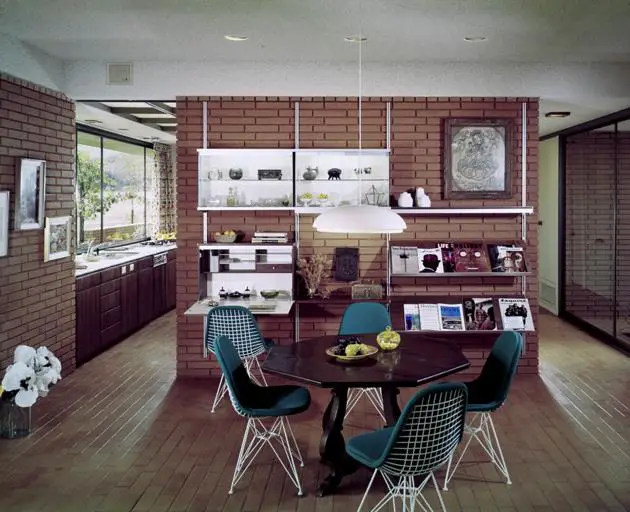
With Case Study House #28, Buff and Hensman focused on creating a functional and stylish home that encouraged the marriage and harmony of external and internal spheres of family life.
By heavily permeating the consistently used brickwork with large glass windows, Case Study Home #28 invites the outside in while maintaining a comfortable and private living space that suits family life and provides a calm, stress-free atmosphere.
Photos via Modernism Rediscovered .

The Case Study Houses Program: Richard Neutra’s Bailey House
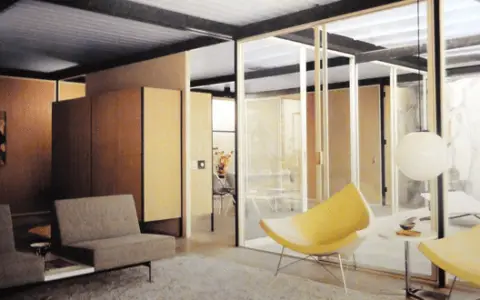
The Case Study Houses Program: Craig Ellwood’s Case Study House 18

The Last Case Study House

- Architecture
- case study house
- photography

Above: Designed by Buff & Hensman and located in Thousand Oaks, California is CSH #28, the last house of Art & Architecture magazine’s Case Study House program. Photo: Julius Shulman / Getty Archives
Located in Thousand Oaks, California Case Study House #28 was the last of the program that began in 1945 by Art & Architecture magazine. The Case Study program was an experiment in American residential architecture whose goal was to create show homes that showcased affordable, modern housing in response to the sudden increase in housing demand created with the return of millions of soldiers after the end of the Second World War. Designed by architect Jack W. Buktenica of the firm of Buff, Hensman and Associates Case Study House #28 was completed in 1966 and demonstrates that after 20 years of the Case Study Program the goal of affordable and modern housing had given way to simply showcasing innovations in modern architectural design and materials. The home is still around today and is listed on the U.S. National Register of Historic Places.
Designed by Buff & Hensman and located in Thousand Oaks California is #28, the last house of Art & Architecture’s Case Study House program. Photo: Julius Shulman / Getty Archives
Here is the text of the article introducing Case Study House #28 as it appeared in Art & Architecture Magazine in 1966.
CASE STUDY HOUSE NO. 28 BY BUFF, HENSMAN & ASSOCIATES, ARCHITECTS
Co-Sponsored by Pacific Clay Products and Janss Corporation
Interiors by Robert P. D’Amico of Ecological Design Associates with Marge Peterek Landscape
Architect: Jack W. Buktenica.
Photographed by Julius Shulman
This Case Study project grew out of a concern with the problems and advantages of face brick as the basic structural material in contemporary single-family residential construction. Despite its wide use in large scale building, face brick is used on the West Coast for its decorative rather than its structural properties, largely because of cost factors, which in turn are the result of stringent reinforcing requirements in building codes and resistance by labor to improved, more efficient construction methods. The architects were asked to design a house that incorporated face brick as the primary structural material to demonstrate its particular advantages. The solution introduces reinforced grouted walls and piers, laid in a standard one-third bond, and designed to take both horizontal and vertical loads and spanned by concealed steel beams. Joining the brick with glass results in a combination of materials requiring no finish and little maintenance during the life of the building.
The site is a knoll overlooking the Conejo Valley development of Janss Corporation 40 miles north of Los Angeles near Thousand Oaks. The house utilizes the site in its entirety, the overall periphery approximating a square and following the boundaries of the usable portion of the lot. In plan the house is composed of two symmetrical wings connected by glass-enclosed galleries. Living, dining, kitchen and study are in one, the five bedrooms in the other of the two parallel 95′ by 19′ wings. The major spaces and the galleries open onto a 54′ by 54′ central court, paved in brick and containing a swimming pool and planted areas, that forms a visual and physical center for the house. The low profile of the house, leaving views from surrounding sites unobstructed, is emphasized by wide overhangs which shade the extensive glass area (4500 square feet). In addition to their visual and sun control functions, the overhangs house continuous duct plenums for carrying conditioned air; the two central brick piers abutting on the interior court each houses the forced-air units for its wing. Thus the necessary heating and cooling elements have been made contributing visual factors in a concept that combines form, function and mechanical environmental controls.
The covered area of the house is about 5000 square feet, including the two connecting galleries. All interior floors are brick paver, relating to the brick of the central court and the terraces and patios; the family of earth colors in the various brick surfaces also integrates the house with the site and the larger environment. The combination of the past with today’s technology in the juxtaposition of the warm, natural brick with the meticulously detailed stainless steel framing for windows and sliding glass doors has also been reflected in the interior design.
Click on image for full view.

CSH #28 today. Designed by Buff & Hensman and located in Thousand Oaks California it is the last house of of Art & Architecture’s Case Study House program.
Check out these great books!

I have been secretly hoping that you would do a series on the Case Study houses, and whether or not you do a series, I love that you wrote about my favorite Case Study house. What interesting info – I did not realize that this was designed to showcase brick as a building material. This is one of those homes that transports me, that makes me feel that I have always known it. Thank you for this article.
Cookie banner
We use cookies and other tracking technologies to improve your browsing experience on our site, show personalized content and targeted ads, analyze site traffic, and understand where our audiences come from. To learn more or opt-out, read our Cookie Policy . Please also read our Privacy Notice and Terms of Use , which became effective December 20, 2019.
By choosing I Accept , you consent to our use of cookies and other tracking technologies.
Share this story

The Case Study houses that made Los Angeles a modernist mecca
Mapping the homes that helped to define an era
Los Angeles is full of fantastic residential architecture styles, from Spanish Colonial Revival to Streamline Moderne. But the modernist Case Study Houses , sponsored by Arts & Architecture and designed between the 1940s and 1960s, are both native to Southern California and particularly emblematic of the region.
The Case Study series showcased homes commissioned by the magazine and designed by some of the most influential designers and architects of the era, including Charles and Ray Eames, Richard Neutra, and Pierre Koenig. The residences were intended to be relatively affordable, replicable houses for post-World War II family living, with an emphasis on “new materials and new techniques in house construction,” as the magazine’s program intro put it.
Technological innovation and practical, economical design features were emphasized—though the homes’ scintillating locations, on roomy lots in neighborhoods like Pacific Palisades and the Hollywood Hills , gave them a luxurious allure.
With the help of photographer Julius Shulman , who shot most of the homes, the most impressive of the homes came to represent not only new styles of home design, but the postwar lifestyle of the booming Southern California region.
A total of 36 houses and apartment buildings were commissioned; a couple dozen were built, and about 20 still stand in the greater Los Angeles area (there’s also one in Northern California, a set near San Diego, and a small apartment complex in Phoenix). Some have been remodeled, but others have been well preserved. Eleven were added to the National Register of Historic Places in 2013.
Here’s a guide to all the houses left to see—but keep in mind that, true to LA form, most are still private residences. The Eames and Stahl houses, two of the most famous Case Study Houses, are regularly open to visitors.
As for the unconventional house numbering, post-1962 A&A publisher David Travers writes that the explanation is “inexplicable, locked in the past.”
Case Study House No. 1
J.R. Davidson (with Greta Davidson) designed this house in 1948 (it was actually his second go at Case Study House No. 1). It was intended for “a hypothetical family" with two working parents and was designed to require "minimum maintenance.”
- Open in Google Maps
:no_upscale()/cdn.vox-cdn.com/uploads/chorus_image/image/62490166/Screen_Shot_2018_06_03_at_7.28.48_PM.0.0.jpg)
Case Study House No. 2
Case Study House No. 2 was designed in 1947 by Sumner Spaulding and John Rex. Arts & Architecture wrote that the home’s layout “achieves a sense of spaciousness and flexibility,” with an open living area and glass doors that lead out to adjoining terraces.
View this post on Instagram A post shared by Samuel Dematraz (@samueldematraz) on Oct 28, 2018 at 1:07am PDT
Case Study House No. 7
Case Study House No. 7 was designed in 1948 by Thornton M. Abell. It has a “three-zone living area,” with space for study, activity, and relaxation/conversation; the areas can be separated by sliding panels or combined.
:no_upscale()/cdn.vox-cdn.com/uploads/chorus_image/image/62490169/gri_2004_r_10_b186_f001_csh7_05.0.0.jpg)
Eames House (Case Study House No. 8)
Legendary designer couple Charles and Ray Eames designed the Eames House in 1949 and even Arts & Architecture seemed kind of blown away by it. The home is built into a hillside behind a row of Eucalyptus trees on a bluff above Pacific Palisades. It's recognizable by its bright blue, red, and yellow panels. The Eameses lived in the house until their deaths. It’s now open to visitors five days per week, though reservations are required.
:no_upscale()/cdn.vox-cdn.com/uploads/chorus_image/image/62490170/shutterstock_1095854573.0.0.jpg)
Entenza House (Case Study House No. 9)
The Entenza House was built in 1949 and designed by Charles Eames and Eero Saarinen for Arts & Architecture editor John Entenza. According to the magazine, “In general, the purpose was to enclose as much space as possible within a reasonably simple construction.”
:no_upscale()/cdn.vox-cdn.com/uploads/chorus_image/image/62490171/gri_2004_r_10_b188_f003_752_07ext.0.0.jpg)
Case Study House No. 10
Case Study House No. 10 was designed in 1947 by Kemper Nomland. The house is built on several levels to mold into its sloping site. Recently restored, the home sold to Kristen Wiig in 2017.
:no_upscale()/cdn.vox-cdn.com/uploads/chorus_image/image/62490172/711_San_Rafael_629v1.0.0.jpg)
Case Study House No. 15
Designed by J.R. Davidson in 1947, Case Study House No. 15 has south walls made of huge glass panels. Its flagstone patio and indoor floor are at the same level for that seamless indoor-outdoor feel. According to the magazine, the floorplan “is basically that of another Davidson house, Case Study House No. 11,” which has been demolished.
View this post on Instagram A post shared by Samuel Dematraz (@samueldematraz) on Nov 15, 2018 at 6:13am PST
Case Study House for 1953
Craig Ellwood’s Case Study House for 1953 is usually numbered as 16 in the Case Study series . It has a modular steel structure and “the basic plan is a four-foot modular rectangle.” But the interior walls stick out past the exterior walls to bring the indoors out and the outdoors in. The Bel Air house hit the market in November with a $3 million price tag.
:no_upscale()/cdn.vox-cdn.com/uploads/chorus_image/image/62490174/2.96.jpg)
Case Study House No. 17 (A)
Case Study House No. 17 (A) was designed by Rodney Walker in 1947. A tight budget kept the house at just 1,560 square feet, “but more space was gained through the use of many glass areas.” The house also has a large front terrace with a fireplace that connects the indoor living room fireplace. The house has been remodeled .
View this post on Instagram A post shared by Case Study House #17, 1947 (@casestudy17) on Jun 11, 2016 at 2:20pm PDT
Case Study House No. 17 (B)
Case Study House No. 17 (B) was designed in 1956 by Craig Ellwood, but “governed by a specific program set forth by the client.” Ellwood took into account the clients' collection of contemporary paintings and made the living room “purposely undersized” to work best for small gatherings. The house was extensively remodeled in the sixties by Hollywood Regency architect John Elgin Woolf and his partner, interior designer Robert Koch Woolf.
View this post on Instagram A post shared by BAUKUNST™ El Arte de Construir (@i_volante) on Aug 13, 2017 at 4:42pm PDT
West House (Case Study House No. 18 [A])
Case Study House No. 18 (A) was designed by Rodney Walker in 1948. The house is oriented toward the ocean, but set back from the cliff edge it sits on to avoid noise issues. As A&A says, "High above the ocean, the privacy of the open south and east exposures of Case Study House No. 18 can be threatened only by an occasional sea-gull." The house features a "bricked garden room" separated from the living room by a two-sided fireplace.
View this post on Instagram A post shared by CaseStudyHouse18A (@casestudyhouse18a) on Oct 6, 2018 at 8:44pm PDT
Fields House (Case Study House No. 18 [B])
Case Study House No. 18 (B) was designed by Craig Ellwood in 1958. Ellwood didn’t attempt to hide that the house was prefabricated (the magazine explains that he believed “that the increasing cost of labor and the decline of the craftsman will within not too many years force a complete mechanization of residential construction methods”). The components of the house, however, are “strongly defined with color: ceiling and panels are off-white and the steel framework is blue.” According to A&A' s website, the house has been remodeled.
View this post on Instagram A post shared by MCM Daily (@dc_hillier) on Oct 29, 2018 at 8:32pm PDT
Case Study House No. 20 [A])
This two-bedroom house was meant “to serve young parents who find they can afford just that much,” according to architect Richard Neutra’s description. He also wrote that he used several different kinds of natural wood in the house.
:no_upscale()/cdn.vox-cdn.com/uploads/chorus_image/image/62490179/gri_2004_r_10_b199_350_27k.112.jpg)
Bass House (Case Study House No. 20 [B])
The Bass House was designed in 1958 by Buff, Straub, and Hensman for famed graphic designer Saul Bass. It's “unique in that it was based upon the experimental use of several prefabricated Douglas fir plywood products as part of the structural concept,” including hollow-core plywood vaults that covered the central part of the house.
:no_upscale()/cdn.vox-cdn.com/uploads/chorus_image/image/62490180/gri_2004_r_10_b186_2675_09.108.jpg)
Case Study House No. 21
Pierre Koenig designed Case Study House No. 21 in 1958. It was originally completely surrounded by water, with a walkway and driveway spanning the moat at the front door and carport, respectively. The house was severely messed with over the years, but restored in the ’90s with help from Koenig.
:no_upscale()/cdn.vox-cdn.com/uploads/chorus_image/image/62490181/gri_2004_r_10_b199_2622_53k.119.jpg)
Stahl House (Case Study House No. 22)
Pierre Koenig's Stahl House , designed in 1960, is probably the most famous house in Los Angeles, thanks to an iconic photo by Julius Shulman . The house isn't much to look at from the street, but its backside is mostly glass surrounding a cliff's-edge pool. Tours are available Mondays, Wednesdays, and Friday—but book well ahead of time, as they sell out quickly.
:no_upscale()/cdn.vox-cdn.com/uploads/chorus_image/image/62490182/gri_2004_r_10_b199_2980_02k.0.0.jpg)
Case Study House for 1950
The unnumbered Case Study House for 1950 was designed by Raphael Soriano. It's rectangular, with living room and bedrooms facing out to the view. However, in the kitchen and eating areas, the house “turns upon itself and living develops around a large kitchen-dining plan opening upon a terrace which leads directly into the living room interrupted only by the mass of two fireplaces.” According to A&A 's website, the house has been remodeled.
:no_upscale()/cdn.vox-cdn.com/uploads/chorus_image/image/62490183/gri_2004_r_10_b192_f004_790_005__1_.121.jpg)
Frank House (Case Study House No. 25)
The two-story Frank House was designed by Killingsworth, Brady, and Smith and Associates in 1962 and it sits on a canal in Long Beach. A reflecting pool with stepping stones leads to its huge front door and inside to an 18-foot high courtyard. The house sold in 2015 with some unfortunate remodeling .
:no_upscale()/cdn.vox-cdn.com/uploads/chorus_image/image/62490184/gri_2004_r_10_b189_f009_3430_17.122.jpg)
Case Study House No. 28
Case Study House No. 28 was designed in 1966 by Conrad Buff and Donald Hensman. According to the magazine, “the architects were asked to design a house that incorporated face brick as the primary structural material to demonstrate its particular advantages.” They came up with a plan for two symmetrical wings joined by glass galleries.
:no_upscale()/cdn.vox-cdn.com/uploads/chorus_image/image/62490185/gri_2004_r_10_b199_4037_26k.132.jpg)
Loading comments...
Site search.
- Los Angeles
- San Francisco
- Archive.curbed.com
- For Sale in LA
- For Rent in LA
- Curbed Comparisons
- Neighborhoods
- Real Estate Market Reports
- Rental Market Reports
- Homelessness
- Development News
- Transportation
- Architecture

- San Francisco
National Register of Historic Places in Ventura County


Case Study House No. 28
Historic house in california, united states / from wikipedia, the free encyclopedia.
The Case Study House No. 28 , at 91 Inverness Rd., Thousand Oaks, California , is the only Case Study House in Ventura County . Built during 1965–66, [2] [3] it was listed on the National Register along with several other Case Study Houses in Los Angeles County on July 24, 2013, as part of the "Case Study House Program NPS ". [1] This one-story flat-roofed house, designed by architects Conrad Buff and Donald Hensman of the firm Buff and Hensman , [2] was the last family home built in the program and one of the largest at 4,500 square feet. The architects designed the house with classic concept in modern architecture of merging interior and exterior spaces through glass expanses and seamless materials. Face brick was incorporated into the house since it is located on a knoll overlooking a development where this was the unifying material. Previous houses in the program consisted primarily of glass and exposed steel , but the Janss Development Corporation and Pacific Clay Products wanted to demonstrate the advantages of the alternative material. [4]
Decorative iron gates at the entrance frame the center courtyard that has a swimming pool. Along with the brick face, the house has more than 4,000 square feet of glass windows that are shaded by overhangs. The owners described how they considered installing double paned glass but found it would not fit into the steel frame; the single paned glass makes the house hot in the summer and cold in the winter. Solar panels have been put on the roof along with replacing the asphalt and gravel material, popular at the time the house was constructed, with white foam. [5]
When the current owners purchased the house in 1987, the previous owners had shared media coverage about the house with them. In 2013, the owner said to the local press, "I fell in love with the house. I saw it as a work of art." [5]

Why list Case Study houses on the National Register?
- Show more sharing options
- Copy Link URL Copied!
Ten Case Study houses from Los Angeles, Ventura and San Diego have been listed on the National Register of Historic Places, the Los Angeles Conservancy announced last week.
The listing includes homes designed by household names of California modernism, such as Charles and Ray Eames, Richard Neutra and Pierre Koenig. All were part of the Case Study program organized by John Entenza, editor of Arts & Architecture magazine, in 1945. The magazine commissioned architects to develop prototype modernist housing for a post-World War II America, and in doing so, the program popularized a sleek aesthetic that endures today. The program encompassed more than three-dozen designs, but not all were actually built and some have been demolished or significantly altered.
The L.A. Conservancy’s Modern Committee spearheaded the National Register nomination, a nearly decade-long effort that culminated with the National Park Service formally listing 10 houses on July 24.
Adrian Scott Fine, the conservancy’s director of advocacy, spoke with us about the importance of this national recognition, what it means for the historic houses and why an 11th home, Case Study House No. 23A, was deemed eligible to be listed but wasn’t because of the owner’s objection.
Question: Why did the L.A. Conservancy go through the trouble of getting these Case Study houses listed?
Answer: It was such an innovative program, instrumental to influencing the design of residences, not just in Southern California but also all over the country. Listing them was to give them the recognition they so dearly deserve.
How did the conservancy choose which homes to nominate?
It was a long process done mostly by volunteers. We focused on properties in Los Angeles County, since we’re an L.A.-based organization. We also looked outside of the county. We eventually trimmed down the list once we met with the owners or saw the property and realized it had too many changes already.
What protection does this listing offer the houses?
It’s pretty limited. Any building on the National Register could, in theory, be demolished. There are different types of designation for historic buildings from the national level down to the local level. It’s most often the local designation that provides real protection. However, we hope that knowing these houses have achieved this level of distinction, homeowners wouldn’t do something that would be detrimental to the home.
To what extent does the National Register listing protect the design?
Being listed doesn’t mean you can’t change anything on the house. You certainly can. The nomination calls out character-defining features. Case Study House No. 18 and No. 22 have innovative glass walls. Case Study House No. 28 has a great interior courtyard. Hopefully, owners wouldn’t change features like that. It would compromise the integrity of the house.
One home that the conservancy nominated was found eligible for designation but wasn’t included in the final listing. Why would an owner object to adding a home to the register?
Some owners were just uncomfortable with people knowing about their house. The other factor was the perceived level of government bureaucracy, which isn’t the case. The former [privacy] was the reason with the one owner who objected. It wasn’t that they didn’t care about the house or that they hadn’t done a good job preserving it.
What benefits are there to being designated?
They get the distinction of being able to say they live in a nationally historic property. Not every property can achieve that level of significance. The property would be eligible for a conservation easement because it’s listed. Owners would then receive a one-time charitable tax deduction for that.
There is also a federal tax credit program that credits 20% of the investment in the properties, but it only applies to income-producing properties. Most of the Case Study houses are individual residences, so this wouldn’t apply.
Considering the conservancy’s submission was a multiple-property nomination, what are the implications for the other Case Study homes not registered?
If any of the houses that were left off want to be included, it would be a really streamlined and easy process to be listed because the hard work has been done. Why these houses are important has already been established. The homeowners can do the specific write-up on their house alone. They don’t have to make a bigger case.
THE LIST: ADDITIONS TO THE NATIONAL REGISTER
Case Study House No. 1, 10152 Toluca Lake Ave., Los Angeles
Case Study House No. 9, 205 Chautauqua Blvd., Los Angeles
Case Study House No. 10, 711 S. San Rafael Ave., Pasadena
Case Study House No. 16, 1811 Bel Air Road, Los Angeles
Case Study House No. 18, 199 Chautauqua Blvd., Los Angeles
Case Study House No. 20, 2275 N. Santa Rosa Ave., Altadena
Case Study House No. 21, 9038 Wonderland Park Ave., Los Angeles
Case Study House No. 22, 1635 Woods Drive, Los Angeles
Case Study House No. 23A, 2342 Rue de Anne, La Jolla, San Diego (eligible but not added)
Case Study House No. 23C, 2339 Rue de Anne, La Jolla, San Diego
Case Study House No. 28, 91 Inverness Road, Thousand Oaks
JOIN THE CONVERSATION:
@latimeshome | pinterest.com/latimeshome | facebook.com/latimeshome | facebook.com/latimesgarden
More to Read

Disney’s biggest shareholder fight in 20 years will shape the company’s future
April 2, 2024

‘I’m a liar. I’m a thief. I’m capable of almost anything.’

9 things to know about the great Disney-Nelson Peltz proxy fight
The biggest entertainment stories
Get our big stories about Hollywood, film, television, music, arts, culture and more right in your inbox as soon as they publish.
You may occasionally receive promotional content from the Los Angeles Times.
More From the Los Angeles Times

15 best native plants to grow in your yard if you also want fragrant bouquets
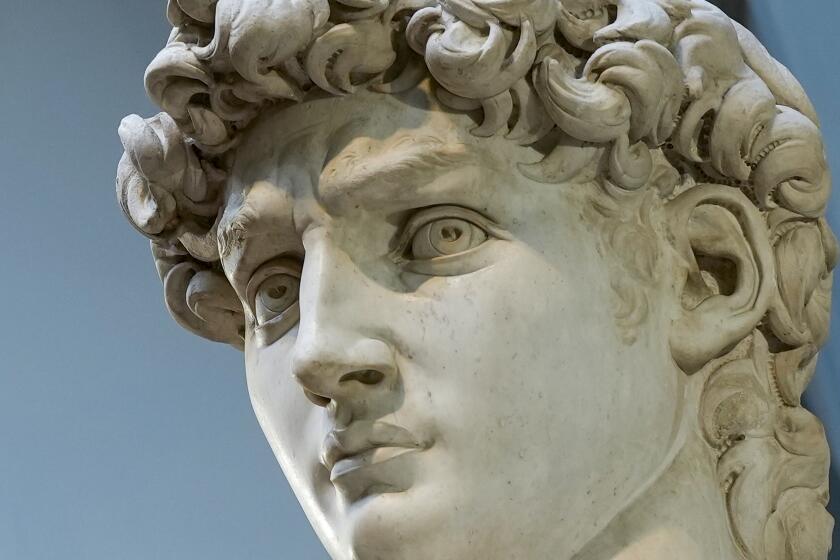
World & Nation
A fight to protect the dignity of Michelangelo’s David raises questions about freedom of expression
April 1, 2024
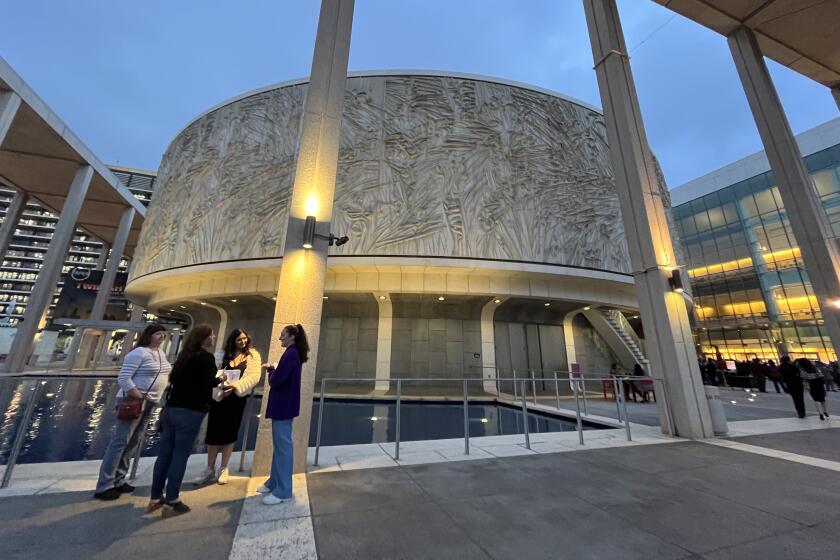
Entertainment & Arts
L.A.’s Mark Taper Forum will reopen, but does Center Theatre Group have a sustainable path forward?

The Broad expansion: What you need to know about the $100-million project
March 28, 2024
You are using an outdated browser. Please upgrade your browser or activate Google Chrome Frame to improve your experience.

Case Study House #28 [1966]
Buff & Hensman

At almost 5000 square feet, Case Study House #28 stands as one of the largest examples in the programme and sprawls over the land with just a single floor. Steel framed, this residence is notable for its use of clay brick that serves to conceal much of the structure whose heaviness is masked by a saturation of clerestory glass windows that serves to integrate the courtyards with the interiors. Buff & Hensman’s plan is simple, two rectangles that are divided by a landscaped court and, in turn, linked by enclosed galleries.
Case Study House #28
By Janss Dev, Located in Thousand Oaks, California.
Detail of Wall by Entrance
- Hispanoamérica
- Work at ArchDaily
- Terms of Use
- Privacy Policy
- Cookie Policy
- United States
AD Classics: Eames House / Charles and Ray Eames
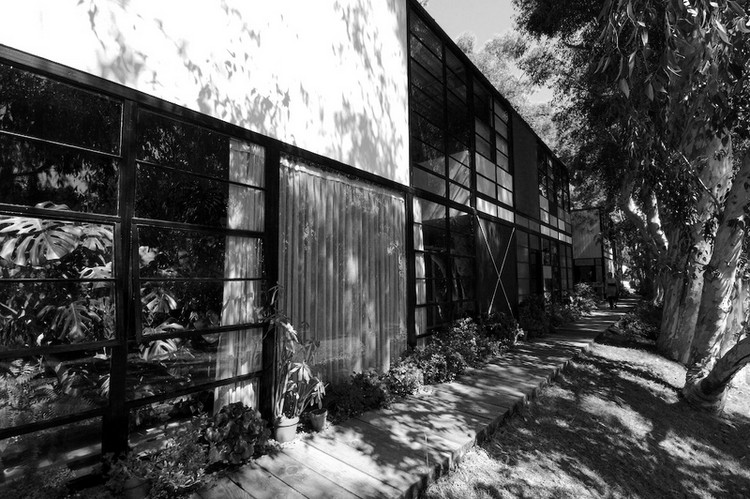
- Written by Adelyn Perez
Text description provided by the architects. Originally known as Case Study House No. 8, the Eames House was such a spatially pleasant modern residence that it became the home of the architects themselves. Charles and Ray Eames began designing the house in 1945 for the Case Study House Program in Los Angeles' Arts and Architecture Magazine published and built these case study homes that had to focus on the use of new materials and technologies developed during World War II. The intention was for the house to be made of prefabricated materials that would not interrupt the site, be easy to build, and exhibit a modern style.

The house is situated on a three-acre site on top of an 150-foot cliff that overlooks the Pacific Ocean. The site is a flat parcel on otherwise steep land that creates a retaining wall to the west. The response to this condition was a concrete retaining wall that ties together the two boxes separated by a courtyard that make up the parti of the residence.

The two boxes serve two different functions. One is for the residence itself and the other is a studio. Both provide double-height spaces at the corners and outer ends of both programs. This allows for a composition that breaks the space up rhythmetically, and is read on the exterior of the house with the exterior courtyard serving as a double-height space in between both boxes.

Along with the retaining concrete wall, a simple steel frame was used for the structure of the house. The steel frame used 4-inch H-columns for the walls and 12-inch deep web joists for the roof. The steel frame was filled in with different solid and transparent colored panels arranged to create a shifting light in the interior throughout the day.

The importance given to light in the design, with the exterior arranged in this particular way, can be connected to Japanese influence. This attention to detail, however, did not hinder the aspect of displaying the idea prefabrication. The house was built largely of standard components, such as the windows which measure a standard width of 3-feet 4-inches.
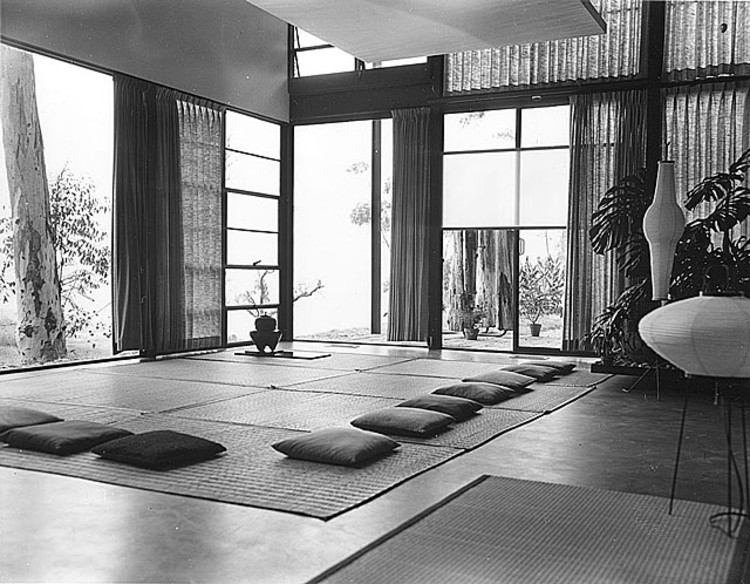
Contrast to the cold steel framing that forms the structure, the interior of the house is warm and comforting with its wood-block floor and the soft light penetrating into each room through each day. Wooden staircases float effortlessly connecting the lower and upper levels. The use of natural materials on the interior bring the residence closer to nature, giving the appearance of the house resting softly on the earth. A row of eucalyptus trees was also planted at the front that provide shade and blend parts of the house with outdoors.

The Eames House is a beautiful continuation of space. The rooms are liberating, flowing into one another even between floors through the double-height spaces. Private and public spaces are not strictly divided. For example, the bedroom on the upper level overlooks the public living room with a short terrace that connects the rooms. There are no major divisions other than the separation of the two boxes, which still merge into one another with the courtyard. The house is an unrolling scroll of a Mondrian painting that exemplifies the use prefabricated materials to create beautiful endless space.

- Architects: Charles and Ray Eames
- Year Completion year of this architecture project Year: 1949
- Photographs Photographs: Flickr - User: An Amateur , Flickr - User: rpa2101 , architectenwerk.nl , Stephen Canon
Project gallery

Materials and Tags
- Sustainability
世界上最受欢迎的建筑网站现已推出你的母语版本!
想浏览archdaily中国吗, you've started following your first account, did you know.
You'll now receive updates based on what you follow! Personalize your stream and start following your favorite authors, offices and users.
Check the latest Chandeliers
Check the latest Wing Chairs
- Español NEW
Case Study House No. 28 facts for kids
The Case Study House No. 28 , at 91 Inverness Rd., Thousand Oaks, California , is the only Case Study House in Ventura County . Built during 1965–66, it was listed on the National Register along with several other Case Study Houses in Los Angeles County on July 24, 2013, as part of the "Case Study House Program NPS ". This one-story flat-roofed house, designed by architects Conrad Buff and Donald Hensman of the firm Buff and Hensman, was the last family home built in the program and one of the largest at 4,500 square feet. The architects designed the house with classic concept in modern architecture of merging interior and exterior spaces through glass expanses and seamless materials. Face brick was incorporated into the house since it is located on a knoll overlooking a development where this was the unifying material. Previous houses in the program consisted primarily of glass and exposed steel, but the Janss Development Corporation and Pacific Clay Products wanted to demonstrate the advantages of the alternative material.
Decorative iron gates at the entrance frame the center courtyard that has a swimming pool. Along with the brick face, the house has more than 4,000 square feet of glass windows that are shaded by overhangs. The owners described how they considered installing double paned glass but found it would not fit into the steel frame; the single paned glass makes the house hot in the summer and cold in the winter. Solar panels have been put on the roof along with replacing the asphalt and gravel material, popular at the time the house was constructed, with white foam.
When the current owners purchased the house in 1987, the previous owners had shared media coverage about the house with them. In 2013, the owner said to the local press, "I fell in love with the house. I saw it as a work of art."
- This page was last modified on 6 November 2023, at 09:15. Suggest an edit .
Nationally recognized historic home to be bequeathed to La Jolla Historical Society
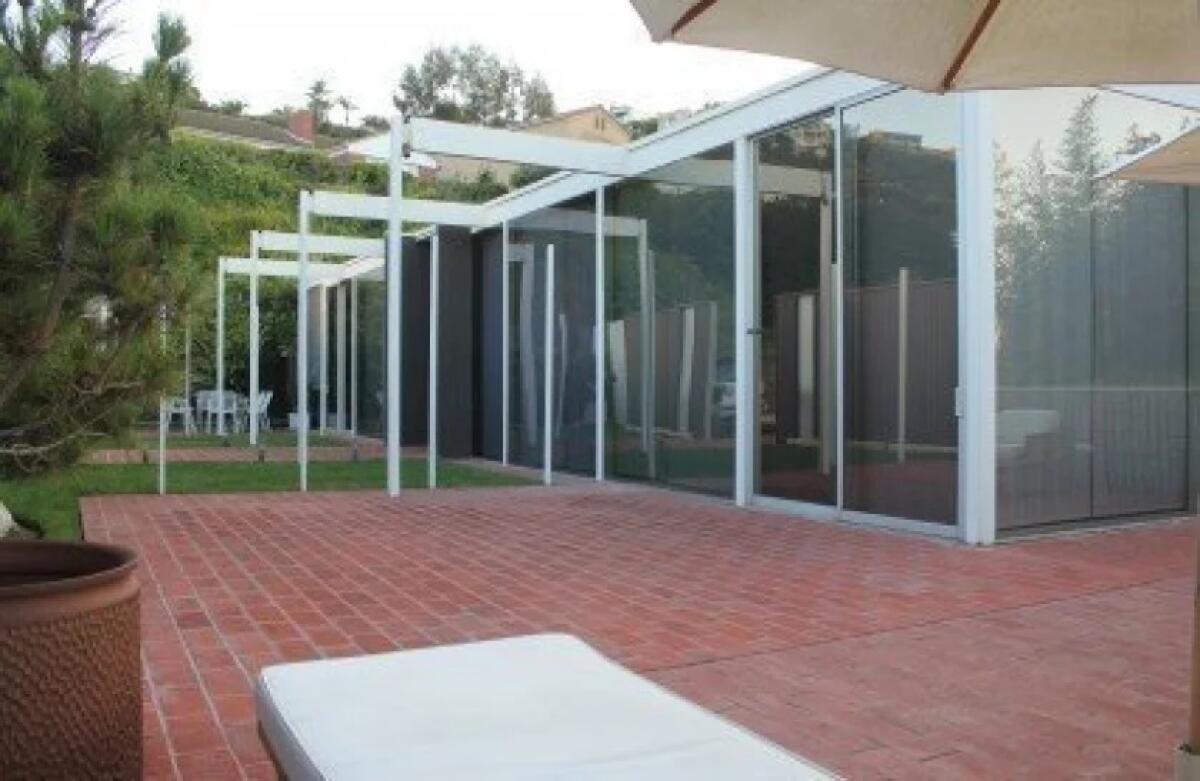
- Show more sharing options
- Copy Link URL Copied!
A house in La Jolla’s Hidden Valley neighborhood described as “the most important single-family home in the La Jolla community” will one day become the property of the La Jolla Historical Society.
In a celebration Sept. 18 to welcome new Historical Society Executive Director Lauren Lockhart and bid farewell to her predecessor, Heath Fox , the announcement was made that upon the deaths of the current homeowners, Nancy, Joseph and Pamela Manno, Case Study House 23C will be gifted to the Historical Society.
“Of all the announcements I’ve made as executive director, this is the last and by far the most important,” Fox told the gathering.
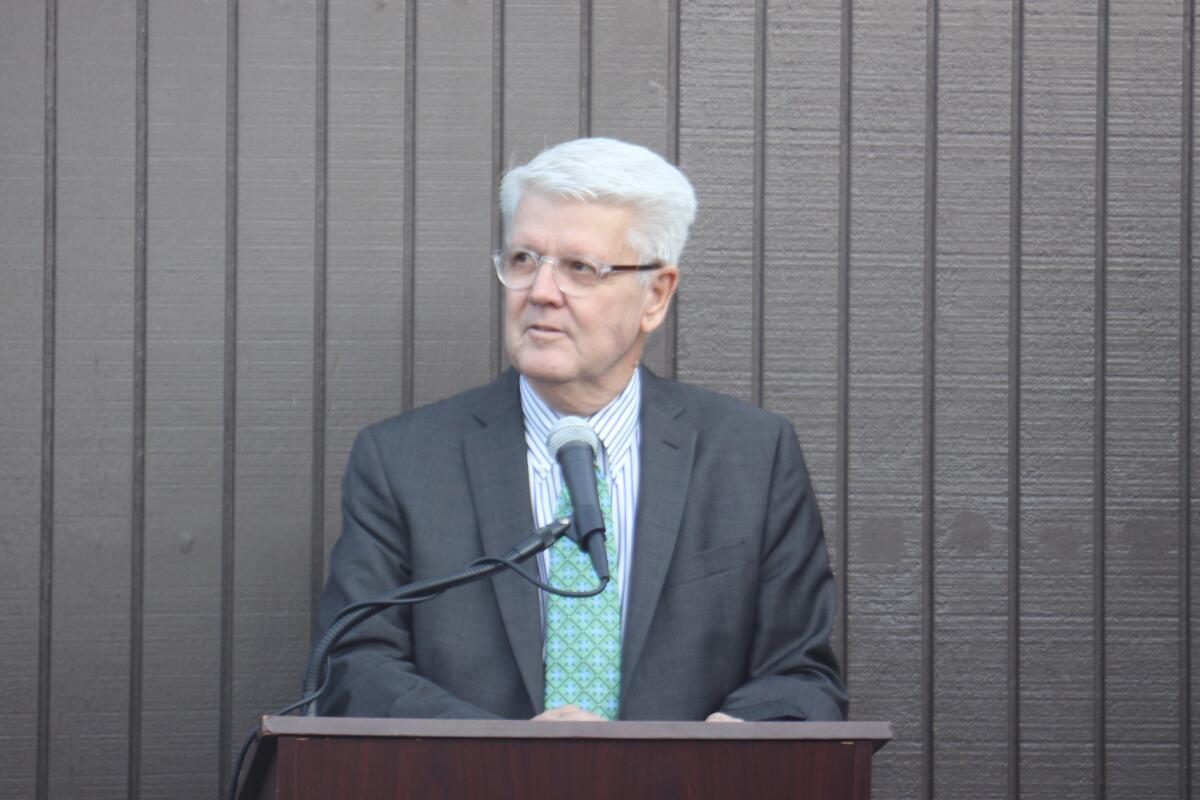
The house, at 2339 Rue de Anne, is listed on the National Register of Historic Places , one of only four houses in La Jolla with such designation.
Fox later told the La Jolla Light that the Historical Society currently does not possess any properties besides its gallery and office location, known as Wisteria Cottage. The hope is to use Case Study House 23C as “an educational and cultural resource for the community of La Jolla, the people of San Diego, the state of California and indeed the nation that has honored it on the National Register of Historic Places,” Fox said. Plans for how that will be done haven’t yet been decided.
“We hope it will be a long time [before we own the house], and we will use that time to do due diligence and look at best practices and the other models of what people have established to make the resource available to the community and to people who are in architecture and design and want to visit and learn from the house,” Fox said.
The Manno family has lived in the house since Nancy and Joseph bought it in 1974.

Speaking for the family, daughter-in-law Pamela said: “Case Study House 23C is a quiet masterpiece. It exemplifies the harmonious relationship between art, architecture and nature. It is a peaceful place that invokes mindful thought, creativity and well-being for our family. We consider ourselves to be stewards of the house and are confident the La Jolla Historical Society is committed to continuing the stewardship. We believe bequeathing Case Study House 23C to the La Jolla Historical Society will ensue the preservation of this special place while educating communities on the significance of historical architecture and art preservation.”
Support Local Journalism
At a time when local news is more important then ever, support from our readers is essential. If you are able to, please become a supporter of the La Jolla Light today by clicking here.
The Case Study House program, which ran from 1945 to 1966, was established by John Entenza, editor and publisher of Los Angeles-based Arts & Architecture magazine. Through the program, major architects of the day were commissioned to design prototype single-family homes in the modern style to test new ideas and concepts of plan, form and materials, Fox said.
“The goal was to represent models that could quickly and efficiently be used in residential development to address the postwar housing shortage,” Fox said. “The program became immensely influential in architectural design, and that is true right down to the present day.”
Through the program, 36 buildings were designed. Among them, 24 houses and one apartment building were constructed, mostly in the Los Angeles area.

The only project in San Diego County consisted of the three houses that make up Case Study House 23 — 23A, 23B and 23C, dubbed “The Triad.” The houses are next to one another on Rue de Anne. House 23C was listed on the National Register of Historic Places in 2013 . House 23A is considered eligible for the National Register. House 23B has been renovated to the point that it is no longer eligible.
“The essence and spirit of the whole historic preservation movement was in the hearts of Nancy and Joseph long before this house was listed on the National Register,” Fox said. “And this is the Manno family legacy, one of invested, thoughtful and committed stewardship. Although we hope it is many years away, when the day comes that ownership of Case Study House 23C passes to the La Jolla Historical Society, the Manno family legacy of stewardship will come with it. This is a responsibility I know the La Jolla Historical Society will embrace with enthusiasm, professionalism and dedication. To Nancy, Joseph and Pamela for your faith, trust [and] confidence in our organization as the inheritors of your legacy, we are humbly and sincerely grateful.” ◆
Get the La Jolla Light weekly in your inbox
News, features and sports about La Jolla, every Thursday for free
You may occasionally receive promotional content from the La Jolla Light.

Become a press patron
Support local journalism.
At a time when local news is more important than ever, support from our readers is essential. If you are able to, please support the La Jolla Light today.
More from this Author
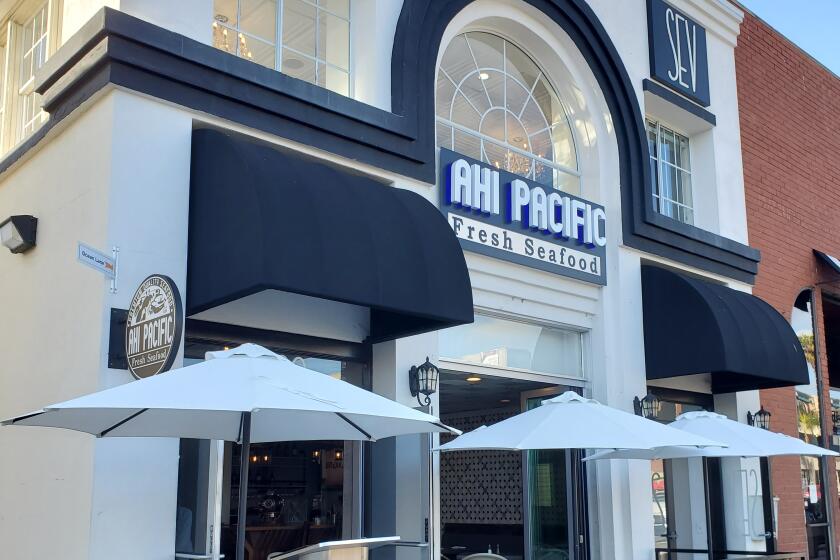
Business News
La Jolla Business Roundup: New shopping, dining and fitness offerings are here or on the way
April 1, 2024
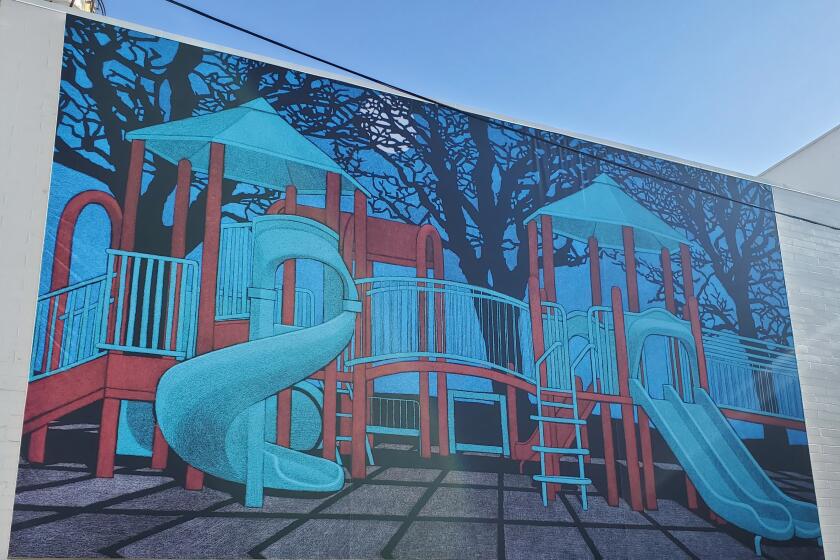
Newest La Jolla mural presents a nighttime playground for the imagination
March 31, 2024

Rare vehicles to take spotlight at La Jolla Concours d’Elegance
March 30, 2024
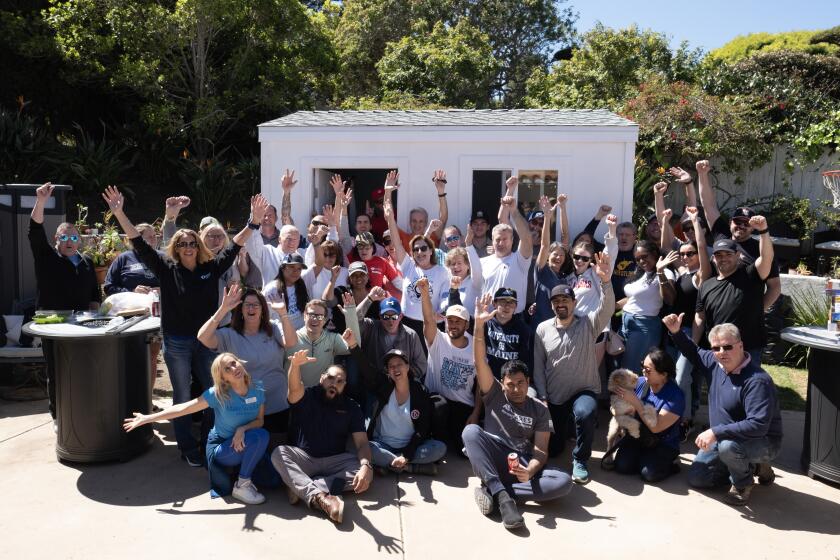
Personalities
Make-A-Wish Foundation builds ‘man cave’ for La Jolla Shores boy
- AI Generator
16 Case Study House No 28 Stock Photos & High-Res Pictures
Browse 16 case study house no 28 photos and images available, or start a new search to explore more photos and images..


Case Study House No. 28
National museum of african american history and culture grand opening ceremony.
The Case Study House #28 , at 91 Inverness Rd., Thousand Oaks, California , is the only Case Study House in Ventura County. Built during 1965-66, it was listed on the National Register along with several other Case Study Houses in Los Angeles County on July 24, 2013, as part of the "Case Study House Program NPS". This one-story flat-roofed house, designed by architects Conrad Buff and Donald Hensman of the firm Buff and Hensman, was the last family home built in the program and one of the largest at 4,500 square feet. The architects designed the house with classic concept in modern architecture of merging interior and exterior spaces through glass expanses and seamless materials. Face brick was incorporated into the house since it is located on a knoll overlooking a development where this was the unifying material. Previous houses in the program consisted primarily of glass and exposed steel, but the Janss Development Corporation and Pacific Clay Products wanted to demonstrate the advantages of the alternative material.
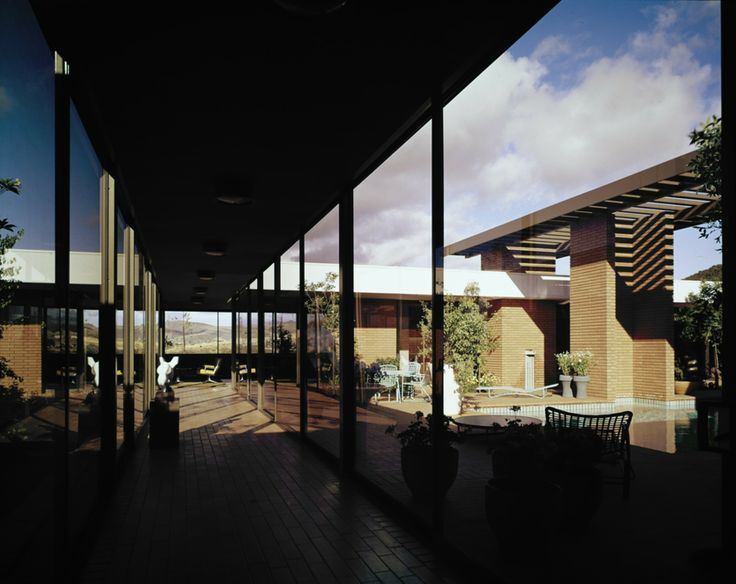
Decorative iron gates at the entrance frame the center courtyard that has a swimming pool. Along with the brick face, the house has more than 4,000 square feet of glass windows that are shaded by overhangs. The owners described how they considered installing double paned glass but found it would not fit into the steel frame; the single paned glass makes the house hot in the summer and cold in the winter. Solar panels have been put on the roof along with replacing the asphalt and gravel material, popular at the time the house was constructed, with white foam.

When the current owners purchased the house in 1987, the previous owners had shared media coverage about the house with them. In 2013, the owner said to the local press, "I fell in love with the house. I saw it as a work of art."
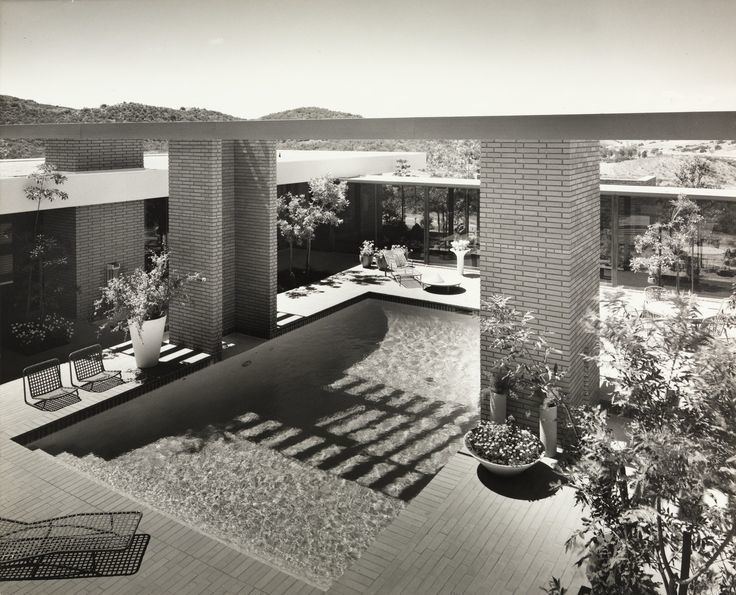
- Google Maps
- Google Maps Street View
- Bing Maps Birds Eye View
- Most Popular
- Colleges / Universities
- Famous Architects
- Famous Homes
- Historic Homes
- Skyscrapers
- More…
- Entertainment
- Amphitheatres
- Roadside Attractions
- Theme Parks
- Water Parks
- Baseball Fields (Pro)
- Baseball Fields (Other)
- Hockey Arenas
- Tennis Stadiums
- Soccer Stadiums
- Military Bases
- Military Air Fields
- Navy / Coast Guard
- Military Communications
- Missile Sites
- Radar Sites
- Censored Imagery
- Transportation
- Lighthouses
- Other…
- Government & Politicians
- Auto Racing
- Advertising / Signs
- Novelty / Interesting
- Retail / Dining
- Street Theater
- Theme Parks / Circuses / Fairs
- Random Objects
- Construction
- Fires / Crashes / Disasters
- People Doing Things
- Birds / Animals
- Parks / Playgrounds
- Cars / Trucks
- Fire / Police / Ambulance
- Military (Active)
- Military (On Display)
- In The News
- Movie Locations
- Murder Sites
- Olympic Sites
- TV Locations
- Artwork - Sculpture
- Artwork - Land Art
- Golf Courses
- Geographic Extremes
- Air - Classic
- Air - Fighter Jets
- Cruise Ships
'Case Study House No. 28' by Buff & Hensman
- 'Case Study House No. 28' by Buff & Hensman
- Nearby (9,968)

- Buildings > Homes - Famous
Collections
- Case Study Houses by fin
Please log in if you don't want to post anonymously (anonymous users cannot post links).
Note: VirtualGlobetrotting is an entertainment website is and is not associated with this post, location or person.
Around the World Mailing List
Case Study House #18 - Arts and Architecture Magazine 1940s - '60s Design Series
News provided by
Mar 28, 2024, 10:00 ET
Share this article
Starting in 1945, Arts and Architecture magazine sponsored some of the modern movement's most famous architects, including Richard Neutra , A. Quincy Jones and Pierre Koenig , to create a series of efficient houses that could be easily replicated for the postwar housing boom. Case Study House #18 is for sale and featured this week at TopTenRealEstateDeals.com.
POMPANO BEACH, Fla. , March 28, 2024 /PRNewswire-PRWeb/ -- Case Study House #18
Modern-style architecture was very popular in the US and Europe between the 1930s and '60s, marked by a stark functional style, geometric lines, and steel-and-glass construction. Integration with the natural landscape is another common feature. Modernism was both an architectural movement and a social movement, which posited that buildings could be the answer to some deep-rooted social inequalities. It was inspired by the German Bauhaus school, which emphasized the standardized construction of apartments for factory workers. When the Nazis came to power, they shut down the school, and Bauhaus-founder Walter Gropius fled to the US, where he taught at Harvard and influenced the rise of the modernist movement. The American architect Frank Lloyd Wright , who called his style "Usonian" - a combination of USA , "utopian" and "organic social order" - was another strong influence. With the end of World War II, a need for homes for returning soldiers led to an explosion of modern architecture, especially in California .
Starting in 1945, Arts and Architecture magazine sponsored some of the modern movement's most famous architects, including Richard Neutra , A. Quincy Jones and Pierre Koenig , to create a series of efficient houses that could be easily replicated for the postwar housing boom. The homes were featured in the magazine in an iconic series of black-and-white photos taken by photographer Julius Shulman . Four of these homes: Case Studies #8, #9, #18, and #20 sit together on a bluff in the Pacific Palisades . Case Study #18 , listed on the National Register of Historic Places, is now for sale. The unique piece of architectural history, designed by Rodney Walker , is listed at $8.9 million .
The beautifully maintained, two-bedroom, two-and-a-half-bath home overlooks the Pacific Ocean. Walls of glass offer big ocean views, and the stunning Will Rogers State Beach is only a two-minute walk away. Tall ceilings and an open floor plan in the dining/living areas provide airy, light-filled spaces and a quintessentially modern aesthetic. The ocean-view bedrooms are tranquil sanctuaries. The indoor-outdoor garden is a unique Rodney Walker touch. The oversize lot includes lush lawns, ocean-facing patios, and a sheltered play area surrounded by mature trees. The sale also includes plans for a second home, designed by Architectural Digest 100 starchitect Tom Kundig .
Pacific Palisades is an upscale LA neighborhood known for its Mediterranean climate, hilly topography, numerous hiking trails, excellent surf beaches, and iconic modern homes. Next door to bustling Santa Monica , it is a close-knit community with a small-town feel. Options for entertainment include the original Getty Villa , the Riviera Country Club, and Temescal Gateway Park. It is set apart from the hustle and bustle of the city but offers convenient freeway access to the Westside, Downtown LA, and Hollywood . Numerous A-listers including Bradley Cooper , Adam Sandler , Anthony Hopkins and NBA All-Star Kawhi Leonard live in the neighborhood.
The listing is held by Crosby Doe of Crosby Doe Associates.
For more celebrity home news and celebrity home video tours , visit TopTenRealEstateDeals.com .
Media Contact
Terry Walsh , TopTenRealEstateDeals.com, 954-544-0526, [email protected] , https://toptenrealestatedeals.com/weekly-ten-best-home-deals
Twitter Facebook LinkedIn
SOURCE TopTenRealEstateDeals.com
Modal title
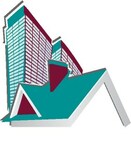

IMAGES
VIDEO
COMMENTS
The Case Study House No. 28, at 91 Inverness Rd., Thousand Oaks, California, is the only Case Study House in Ventura County. Built during 1965-66, it was listed on the National Register along with several other Case Study Houses in Los Angeles County on July 24, 2013, as part of the "Case Study House Program NPS".
Property Type. Case Study House #28 was the last single-family house built under the auspices of Arts & Architecture magazine's Case Study House program. At 5,000 square feet, it is also among the largest. Construction began in 1965 and the residence was completed in 1966. It was built on a knoll overlooking the Janss Development Corporation ...
The only house of its kind to be built in Ventura County, California, Case Study House #28 was the last single-family home designed and constructed by renowned architects Conrad Buff and Donald Hensman of the firm Buff, Hensman and Associates (now Buff, Smith and Hensman). Covering almost 5,000 square feet, #28 is one of the.
Here is the text of the article introducing Case Study House #28 as it appeared in Art & Architecture Magazine in 1966. CASE STUDY HOUSE NO. 28 BY BUFF, HENSMAN & ASSOCIATES, ARCHITECTS. Co-Sponsored by Pacific Clay Products and Janss Corporation. Interiors by Robert P. D'Amico of Ecological Design Associates with Marge Peterek Landscape
Case Study House #28 was designed by Conrad Buff and Donald Hensman of the architectural firm Buff and Hensman. This one-story, flat-roofed residence was built in 1966 on a knoll overlooking the Conejo Development of the Janss Development Corporation 40 miles north of Los Angeles in Thousand Oaks.
Case Study House No. 28 was designed in 1966 by Conrad Buff and Donald Hensman. According to the magazine, "the architects were asked to design a house that incorporated face brick as the ...
Case Study House No. 28 was the last single-family house built under the auspices of the Case Study House Program and among the largest. Although of steel frame construction, the house is sheathed in face brick tempered through the extensive use of glass walls. The property was designed by master architects Conrad Buff and Donald Hensman.
The Case Study House No. 28, at 91 Inverness Rd., Thousand Oaks, California, is the only Case Study House in Ventura County. Built during 1965-66, it was listed on the National Register along with several other Case Study Houses in Los Angeles County on July 24, 2013, as part of the "Case Study House Program NPS". This one-story flat-roofed house, designed by architects Conrad Buff and ...
Finally, melting the barriers between interior and exterior through the extensive use of glass, Case Study House 28 incorporated a total of 4500 square feet of glass windows shaded by large overhangs.
Case Study House No. 23A, 2342 Rue de Anne, La Jolla, San Diego (eligible but not added) Case Study House No. 23C, 2339 Rue de Anne, La Jolla, San Diego Case Study House No. 28, 91 Inverness Road ...
Case Study House #28 [1966] At almost 5000 square feet, Case Study House #28 stands as one of the largest examples in the programme and sprawls over the land with just a single floor. Steel framed, this residence is notable for its use of clay brick that serves to conceal much of the structure whose heaviness is masked by a saturation of ...
Case Study House #16, 1811 Bel Air Rd., Los Angeles Case Study House #18, 199 Chautauqua Blvd., Los Angeles Case Study House #20, 2275 N. Santa Rosa Ave., Altadena Case Study House #21, 9038 ...
Case Study House #28. By Janss Dev, Located in Thousand Oaks, California. Detail of Wall by Entrance. The images below illustrate the assembly of the model. Below is documentation and renders of the house.
The Stahl House, Case Study House #22. The Case Study Houses were experiments in American residential architecture sponsored by Arts & Architecture magazine, which commissioned major architects of the day, including Richard Neutra, Raphael Soriano, Craig Ellwood, Charles and Ray Eames, Pierre Koenig, Eero Saarinen, A. Quincy Jones, Edward Killingsworth, and Ralph Rapson to design and build ...
Completed in 1949 in Los Angeles, United States. Originally known as Case Study House No. 8, the Eames House was such a spatially pleasant modern residence that it became the home of the architects...
Featured in Palm Springs Life Magazine. The case study house program was an experimental program set up by John Entenza through Arts and Architecture Magazine, that facilitated the design, construction and publishing of modern single-family homes. The goal was to highlight modern homes constructed with industrial materials and techniques that ...
The Case Study House No. 28, at 91 Inverness Rd., Thousand Oaks, California, is the only Case Study House in Ventura County.Built during 1965-66, it was listed on the National Register along with several other Case Study Houses in Los Angeles County on July 24, 2013, as part of the "Case Study House Program NPS".This one-story flat-roofed house, designed by architects Conrad Buff and Donald ...
The Case Study House program, which ran from 1945 to 1966, was established by John Entenza, editor and publisher of Los Angeles-based Arts & Architecture magazine. Through the program, major architects of the day were commissioned to design prototype single-family homes in the modern style to test new ideas and concepts of plan, form and materials, Fox said.
Freelancers working on new projects. of 1. Browse Getty Images' premium collection of high-quality, authentic Case Study House No 28 stock photos, royalty-free images, and pictures. Case Study House No 28 stock photos are available in a variety of sizes and formats to fit your needs.
The Case Study House #28, at 91 Inverness Rd., Thousand Oaks, California, is the only Case Study House in Ventura County.Built during 1965-66, it was listed on the National Register along with several other Case Study Houses in Los Angeles County on July 24, 2013, as part of the "Case Study House Program NPS". This one-story flat-roofed house, designed by architects Conrad Buff and Donald ...
See 'Case Study House No. 28' by Buff & Hensman in Thousand Oaks, CA, as it appears on Google Maps and Bing Maps as well as other celebrity homes on VirtualGlobetrotting.com.
The Stahl House (also known as Case Study House #22) is a modernist-styled house designed by architect Pierre Koenig in the Hollywood Hills section of Los Angeles, California, which is known as a frequent set location in American films.Photographic and anecdotal evidence shows that the architect's client, Buck Stahl, provided the inspiration for the overall cantilevered structure.
POMPANO BEACH, Fla., March 28, 2024 /PRNewswire-PRWeb/ -- Case Study House #18 Modern-style architecture was very popular in the US and Europe between the 1930s and '60s, marked by a stark functional style, geometric lines, and steel-and-glass construction.
Case Study House No. 28. This article was reviewed by member (s) of WikiProject Articles for creation. The project works to allow users to contribute quality articles and media files to the encyclopedia and track their progress as they are developed. To participate, please visit the project page for more information.